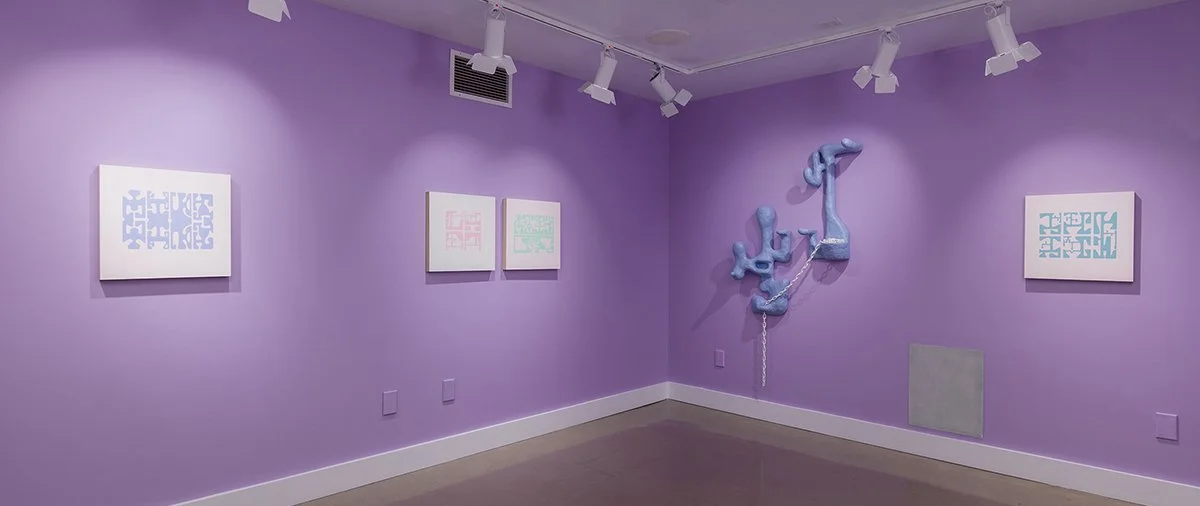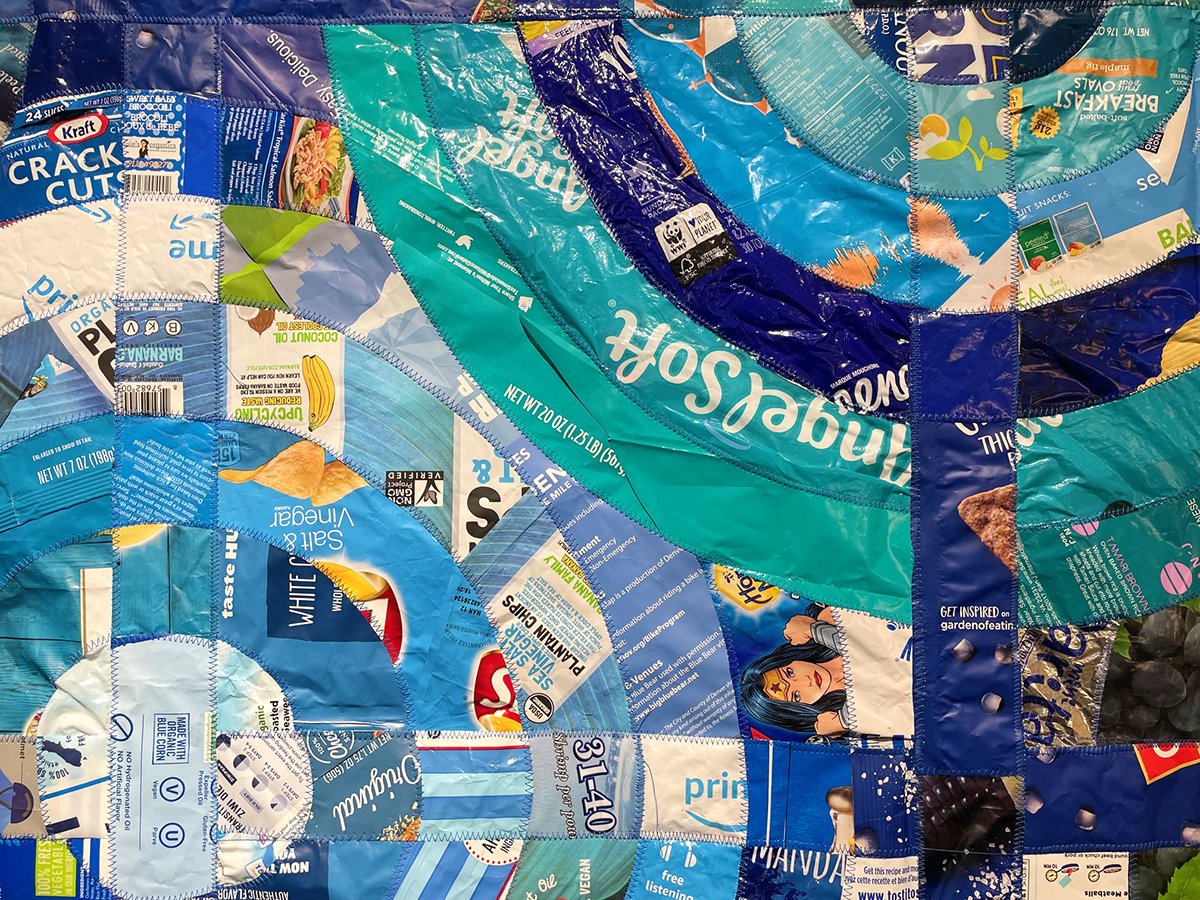All by Dani/elle Cunningham
At the Lincoln Center Art Gallery in Fort Collins, Barbara Baer and Amelia Furman are paired in the exhibition Biophilia for their shared affinity for nature and their use of multimedia, resulting in an energetic show that offers a range of experiences from fixed to immersive. Both artists replicate aspects of the natural world, emphasizing interconnected experiences while creating space for the emergence of new narratives. Through their distinct yet complementary approaches, Baer and Furman invite viewers to engage with the natural world and each other in thought-provoking ways, blending time, environment, and the human experience.
The Dairy Arts Center’s exhibition Black Futures in Art: The Space Between Us reimagines rigid boundaries as permeable gray areas and proposes differences among people as opportunities for collaboration. Guest curated by Adderly Grant-Lord, who also has paintings in the show, this group of Black artists and allies suggest moving forward into our collectively uncertain future without forgetting what’s behind, using past experiences, including traumas, to build strong communities. Focusing on the energy that thrives in creative spaces, this exhibition reminds viewers to use this energy as a catalyst for inclusive relationships and comfort within liminality.
At the University of Northern Colorado’s Campus Commons Gallery, Caminos Por Andar: Latinx Futurism and Expanded Realities presents anti-colonial visions of the future. In this exhibition, a cyborgean creature composed of human detritus and dirt emerges, white settlers are recast as extraterrestrials, and the Madonna and Child become residents of a modern-day border town. Many of the artworks employ a familiar futuristic aesthetic—sharp angles, ambient light, and an emphasis on technology—while others are subtle, reminding viewers that the future isn’t always a Star Trekian utopia, nor is it singular.
For more than twenty years, Zip37 was an artist-run gallery at 37th Avenue and Navajo Street in Denver and was part of what was then the Navajo Street Art District. Though that art district has declined, Zip37 and its many recognizable artists are celebrated in a new exhibition at Kanon Collective in Lakewood’s 40 West Arts District, where many Navajo Street galleries relocated.
Understudy Art Incubation Space has a unique, fishbowl-like design, with floor-to-ceiling windows that invite passersby to either observe art from the outside or physically experience it inside. Enhanced by the gallery’s compact layout, Tricia Waddell’s immersive solo exhibition, We Will Be Strange, emphasizes phenomenology, a philosophy that focuses on how the body shapes perception.
Rounding out the summer, three exhibitions at Blo Back Gallery in Pueblo explore different perspectives from Colorado-based artists Christine Rose Curry, Kim Sewell, and Adam Toksöz. Together, these exhibitions reflect the dynamic and diverse artistic voices Colorado has to offer, each contributing to a broader dialogue on modern issues and personal expression.
The latest exhibition at SeeSaw Gallery, “Oscillations,” features four artists who unravel their connections to place and demonstrate the interplay between instinct and honed technical skills. While each brings a unique perspective to the show, curator Hayley Schneider expertly weaves together a cohesive and harmonious collection featuring Leslie Fitzsimmons, Jamie Gray, Ilan Gutin, and Autumn T. Thomas. The result is an atmosphere of serenity that ignites introspection, contemplation about the artmaking process, and commentary on the relationship between artists and their materials.
The artist-run gallery NKollectiv is currently hosting its second annual encaustic invitational, which showcases the work of sixteen Colorado artists specializing in this ancient art form. Named Apis Opus, the exhibition cleverly combines the world of bees and art, highlighting beeswax as the primary medium in encaustic work. Encaustic is made by heating layers of beeswax mixed with pigment and applying it to different substrates.
With fifty years in operation as one of only a few Colorado non-profits dedicated exclusively to weaving, the Northern Colorado Weavers Guild’s (NCWG) mission of sharing knowledge is apparent in the Northern Colorado Weavers Guild: Celebrating 50 Years exhibition at the Loveland Museum. Members display their considerable skills while demonstrating an array of traditional techniques and objects, from clothing and stuffed animals to contemporary wall hangings. NCWG further extends its educational mission by displaying the tools of its trade, including a drum carder that prepares fiber for spinning, a spinning wheel used to prepare fiber for weaving, a loom on which fiber is woven, and many other objects.
Plinth Gallery owner and exhibition artist Jonathan Kaplan “leaves dogma to religion” rather than ceramics. Instead, he believes design possibilities are limitless and adapting to one’s environment is crucial to the creative process. This exhibition, The Crux of the Biscuit, is the artist’s first body of work since 2021 and showcases his decades of work as a bike builder and potter, as well as his training as a ceramicist. Kaplan has a true knack for bringing disparate parts into a whole that is not only cohesive but whimsical.
The Arvada Center’s three newest exhibitions explore the history, traditions, and aesthetic of the San Luis Valley, affectionately known as the Valley. In the Main Gallery, Emilio Lobato’s retrospective A Mi Manera: A 40-Year Survey encompasses the Valley native’s innovation and numerous stylistic changes. Meanwhile, two group exhibitions, Latitude 37°: Art of Southern Colorado and Colcha Embroidery of the San Luis Valley, embody the region’s influence and relationship to colonialism and hybridity, respectively.
Cabell has always worked with re-purposed materials in a subversion of human consumption and waste, while Bailey focuses on conservation education through photography. Though the artists work in markedly divergent mediums, these shared interests became connective points. With Light Contrasting with Dark, their second collaborative exhibition at the Artists on Santa Fe gallery in Denver, Bailey and Cabell have honed their artistic relationship, generating unexpectedly cohesive works that are as natural as their subject matter.
This Fiber Art International exhibition at the Museum of Art Fort Collins praises the handmade and the materiality of objects, revealing that many artists still enjoy interacting physically with their work. Although AI-generated artwork isn’t likely to disappear, it seems that neither is fiber art. The strong relationship between artists and objects is profoundly felt and impacts their selection of materials and concepts, ranging from the macro to the micro, demonstrating that art can be made from anything.
Talent from Colorado and beyond shines in “Prismatic,” as does the breadth of the queer artist community. More than that though, this exhibition illustrates that art doesn’t occur in a vacuum. Life experiences lead to ideas and influence artistic styles, generating concepts to which the public can relate. Maybe minds won’t be made more inclusive or accepting by this exhibition, as it seems largely tailored to a queer or an already-receptive audience, but minds will certainly be strengthened in the idea that there is no such thing as identity, singular.
At 3 Square Art (3SA) Gallery’s 4th annual juried Art in Black and White exhibition in Fort Collins, curator and gallery owner Kumiko S. McKee leans into this novelty, assembling 51 works by 29 Colorado artists and one Chinese artist. Working in vastly different media, these artists are a dynamic example of not only regional and international talent, but the boundlessness of a classic style.
While many wax nostalgic about their favorite childhood foods or those specific to their culture, food plays a deeper, sometimes mystical role in Colorado artists’ work at History Colorado Center’s new exhibition Colorado’s Asian Food Culture: Rice & Resilience. The Japanese Arts Network and Asian Pacific Islander (API) community partnered with the museum for this exhibition, pairing Asian artists’ voices with testimonies from restaurateurs and other community members to highlight the wealth of Asian cuisine in the state and food’s ability to transmit generational knowledge.
In Amber Cobb’s new paintings and sculptures on display in the exhibition “A Wink is Just a Wink” at Meow Wolf Denver’s Galleri Gallery, the artist uses the grid as a tool of order and chaos, a seemingly conflicted notion that introduces in systems like linguistics and spatial dynamics and encourages viewers to explore spaces beyond boundaries.
The relationship between presence and trace dominates in two exhibitions by Boulder- and Limassol, Cyprus-based artist Marina Kassianidou. Trained in art and computer science, Kassianidou focuses on mark-making and surface and the ways in which drawing is a responsive combination of both. She also emphasizes the role of multistep, transformational processes by displaying each step of creation as artworks in their own right. In geometric frustrations at east window SOUTH in Boulder, Kassianidou illustrates the process of evolving trash into glorified art objects. The artist’s love of mark-making is apparent in her two-person exhibition Volumes at Lane Meyer Projects in Denver with Maia Ruth Lee.
Monstrous cedar sculptures as large as small trees characterize Ursula von Rydingsvard’s exhibition The Contour of Feeling at the Denver Botanic Gardens. The title reflects both the poetics of the sculptures and the tragic, triumphant poetry that could be made about the artist’s childhood. Along with her family, German-born Ukrainian and Polish artist Ursula von Rydingsvard spent her early years as a forced laborer under the Nazis. After World War II, the family traveled among displacement camps. These are experiences she sometimes references in her work, though minimally.
In the exhibition Patterns of Consumption at the Littleton Museum, Kalliopi Monoyios converts cast aside objects, including single-use plastic, cords, and snack packaging, into new states of being as art materials, quilt-like wall hangings, sculptures, and three-dimensional framed works ranging from minimalist to maximalist styles that are nearly unrecognizable from their original forms.





















